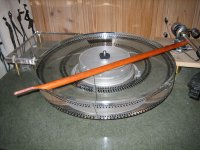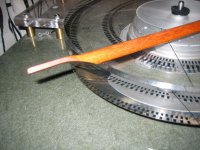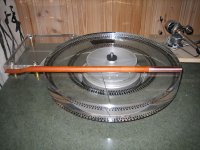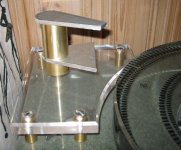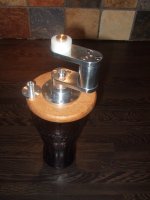Titanium is non porous :^)
JD
JD
Fran,
Are you planning to give it a mineral bath? Oils of differing viscosity?
If so which ones do you favor?
Jeffery Davidson,
What did you use, If I may ask?
I've soaked my mahogany arm wand in tung, WD40, and gun stock oil.
Ron
Not true Jeffrey... 
Check this out:
Titanium foams replace injured bones - Research News 09-2010-Topic 1 ? Fraunhofer-Gesellschaft
You gotta stay on top of your game, hahaha...
Cheerio,
Frank
Check this out:
Titanium foams replace injured bones - Research News 09-2010-Topic 1 ? Fraunhofer-Gesellschaft
You gotta stay on top of your game, hahaha...
Cheerio,
Frank
My only experience in this kind of thing was in making some flutes and uileann pipes. The habit regarding oiling was to use boiled linseed oil, and oil once a minute for 7 minutes, once and hour for 7 hours, once a day for seven days..... and you get the idea. I did hear of one guy who put the roughed out flutes/chanters in a chamber submerged in oil, then pulled a high vacuum on the chamber for a few days. The theory was that the air was evacuated and the oil got "sucked" into the timber, penetrating further and quicker than would normally be possible.
Personally I sand to get the finish I want, and then oil to put a protective surface on. I don't believe that more oil is going to make the timber any more stable, however it may, may, contribute to changing the resonance a bit or something. Either the wood is stable already or it isn't. Works of man are not really going to stop it warping or splitting once it decides to do it. The only exception might be in thin walled stuff where the wood is thin enough to be bonded to another stable surface (my idea with the CF tube up the middle).
I sometimes use organoil - it gives quite a nice stain finish and is easy and quick to apply.
Fran
Personally I sand to get the finish I want, and then oil to put a protective surface on. I don't believe that more oil is going to make the timber any more stable, however it may, may, contribute to changing the resonance a bit or something. Either the wood is stable already or it isn't. Works of man are not really going to stop it warping or splitting once it decides to do it. The only exception might be in thin walled stuff where the wood is thin enough to be bonded to another stable surface (my idea with the CF tube up the middle).
I sometimes use organoil - it gives quite a nice stain finish and is easy and quick to apply.
Fran
Ya, forgot I read that last week, I wonder at what frequency it would resonate in tonearm usage.
JD
JD
Not true Jeffrey...
Check this out:
Titanium foams replace injured bones - Research News 09-2010-Topic 1 ? Fraunhofer-Gesellschaft
You gotta stay on top of your game, hahaha...
Cheerio,
Frank
More progress tonight. New bottom magnet block, new piece machined for top piece that holds the top suspension. Now the next thing up is to bore a second arm wand!
I think I will try to reuse the old headshell, and I will probably insert a short piece of CF both ends to help strengthen where the wood meets the metal. Hopefully that won't affect the performance of the arm.
Fran
I think I will try to reuse the old headshell, and I will probably insert a short piece of CF both ends to help strengthen where the wood meets the metal. Hopefully that won't affect the performance of the arm.
Fran
Dow Corning Glass Foam...
Frank: Dow Corning make glass foam which is used as Cryo tank insulation. This material looks like a silver gray large pour pumice stone. It is incredibly light weight and very hard/rigid. The foam is very easy to work and shape. You can shape it in your hand with a pocket knife blade. Easy to machine and bonds with a number of different adhesives. You might want to check it out. Hope that this is of interest. I looked into this as a possible arm wand material.
I also looked into making an organic foam using Sitka Spruce wood powder. It can be turned into a natural foam by making bread with the wood powder instead of flower. A small quantity of PVA adhesive mixed into the dough keeps it safe from rot and bugs (and insures it all stays together) and when the wood bread is baked and dries it is quite light yet strong like a bread stick. Forms can be used to bake up most any shape you might desire. Glue on a wooden head shell and a wooden end block for mounting a counter weight and you are good to go. A little out of the box but I wanted to have an organic foam and I felt Sitka Spruce would be a natural choice since it is used in so many fine instruments. All the best Moray James.
Frank: Dow Corning make glass foam which is used as Cryo tank insulation. This material looks like a silver gray large pour pumice stone. It is incredibly light weight and very hard/rigid. The foam is very easy to work and shape. You can shape it in your hand with a pocket knife blade. Easy to machine and bonds with a number of different adhesives. You might want to check it out. Hope that this is of interest. I looked into this as a possible arm wand material.
I also looked into making an organic foam using Sitka Spruce wood powder. It can be turned into a natural foam by making bread with the wood powder instead of flower. A small quantity of PVA adhesive mixed into the dough keeps it safe from rot and bugs (and insures it all stays together) and when the wood bread is baked and dries it is quite light yet strong like a bread stick. Forms can be used to bake up most any shape you might desire. Glue on a wooden head shell and a wooden end block for mounting a counter weight and you are good to go. A little out of the box but I wanted to have an organic foam and I felt Sitka Spruce would be a natural choice since it is used in so many fine instruments. All the best Moray James.
Not true Jeffrey...
Check this out:
Titanium foams replace injured bones - Research News 09-2010-Topic 1 ? Fraunhofer-Gesellschaft
You gotta stay on top of your game, hahaha...
Cheerio,
Frank
A new paddle for my diy turntable...
A few years ago I got a cocombole stick, and at last I've got the chance to start working on it. I have a long way to go, but I have at least done a little.
It is nice to have found this thread, a lot of questions answered already, and a lot of problems solved (I think). But there sure will become more of them.
A few years ago I got a cocombole stick, and at last I've got the chance to start working on it. I have a long way to go, but I have at least done a little.
It is nice to have found this thread, a lot of questions answered already, and a lot of problems solved (I think). But there sure will become more of them.
Attachments
Just to keep things hot, i have fabricated some of the metal parts for a lightweight version, for a suspended subchassis TT, i am trying to keep the weight down to a minimum, so i have used delrin in places instead of brass.
Just the armwand to make.
By the way Moray, on the subject of suitable material for arm wands, do not forget that a tonearm, unlike a musical instrument, does not want to vibrate in sympathy with the stylus, as stitka spruce does with the strings.
In fact what is required for a tonearm is the exact opposite of the requirements of a musical instrument soundboard.
Woods such as ebony that do make good tonearms are quite oily and acousticaly non resonant, therfore the use of such woods on musical instruments is restricted to fretboards and such like, mainly due to there good stability and hardness.
Just the armwand to make.
By the way Moray, on the subject of suitable material for arm wands, do not forget that a tonearm, unlike a musical instrument, does not want to vibrate in sympathy with the stylus, as stitka spruce does with the strings.
In fact what is required for a tonearm is the exact opposite of the requirements of a musical instrument soundboard.
Woods such as ebony that do make good tonearms are quite oily and acousticaly non resonant, therfore the use of such woods on musical instruments is restricted to fretboards and such like, mainly due to there good stability and hardness.
Attachments
Velvetsunrise: quite trure but what ever material is used it will sing at some frequency and a broad even response with a moderate Q is more desirable to a narrow peak with a high Q. An organic foam structure is going to be quite different in nature when compared to a solid material (though Altmann's original was a solid Spruce wand). The wood foam will be much lighter in terms of its mass for a given size wand as well as having significantly greater internal loss when compared to a solid structure nor will it will have a high Q resonant character. Many users seem to find materials such as Carbon composite to be dead sounding and prefer wooden wands of many hardwood types such as Cherry, Mahogany and others. Sitka Spruce has an even broad band resonant qualities which in a foam format will be much subdued but I think still similar in spectrum to a solid. There are excellent examples of many different woods use for arm wands so I think that there is a lot of room to experiment and perhaps no hard fast "rules" by which to go by just yet. If you want hard and rigid then the glass foam is a definite option with a hardness of 6 on the Mohs scale you would need to get into the likes of tungsten (9 on the Mohs scale) to find a significantly harder material. Tool steel is softer than glass. Self damping is often overlooked when hard materials are considered. Just my thoughts on the topic and I am no expert by any means. A good discussion in this thread. Nice work by the way.
The wood foam will be much lighter in terms of its mass for a given size wand as well as having significantly greater internal loss when compared to a solid structure nor will it will have a high Q resonant character.
Moray,
I was with you up until the point of "significantly greater internal loss" ??? Are you referring to it's resonant qualities?
Forgive me if it's obvious, I'm learning with every post on this thread.
Ron
I cant speak for composite materials as i havent tried them, but i agree some hardwoods commonly used as tonearm material have resonances in quite a narrow band of lowish frequences, with a highish Q, when compared to spruce, which is more broad band in nature though for typical armwand sizes and masses, the spruce i believe has higher amplitude resonances accros the board.
Maybe the lower frequency high Q resonances in ebony etc, are less excited due to to the RIAA cutting of the record, as there is much less energy imparted into the arm at lower frequencys.
I have a huge pile of ebony dust bagged up, saved from many previous armwands, maybe i should try an ebony breadstick!
Maybe the lower frequency high Q resonances in ebony etc, are less excited due to to the RIAA cutting of the record, as there is much less energy imparted into the arm at lower frequencys.
I have a huge pile of ebony dust bagged up, saved from many previous armwands, maybe i should try an ebony breadstick!
Ron: I am with you this is such a great forum to learn from and get ideas and support. When I was referring to internal loss I was talking about the materials self damping qualities. So if you were to cast a bell out of iron and the same bell out of lead, the lead bell would have greater internal loss. Its resonant character would have a lower energy level or Q when compared to the iron bell. A foam structure can bel be rigid while at the same time the cell structure will flex and dissipate energy self damping at the same time. The foam structure will not store as much energy as a sold one would. I am not an engineer so forgive me if I have been confusing with the terms used to describe this.
I have a huge pile of ebony dust bagged up, saved from many previous armwands, maybe i should try an ebony breadstick!
humm
Velversunrise: Frank probably has more experience with wands made of different woods. Both he and his customers have commented on how they sound compared to metals and composite. Perhaps Frank can give a brief overview on the sonic impact of wand material.
I spoke at length to two different master bakers about making wood bread. Interestingly neither was in the least phased when I asked about making bread with wood flour. Both told me much the same that no rising agent would be necessary (baking powder, baking soda or yeast). Only the wood flour and water. If you bake some ebony you can have a Pumpernickel arm wand. The option of composite blends of multiple wood flours is endless. Have some fun and keep up posted.
I spoke at length to two different master bakers about making wood bread. Interestingly neither was in the least phased when I asked about making bread with wood flour. Both told me much the same that no rising agent would be necessary (baking powder, baking soda or yeast). Only the wood flour and water. If you bake some ebony you can have a Pumpernickel arm wand. The option of composite blends of multiple wood flours is endless. Have some fun and keep up posted.
- Home
- Source & Line
- Analogue Source
- DIY Schroeder Tonearm???
